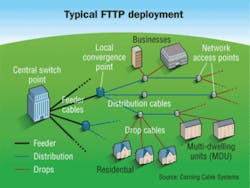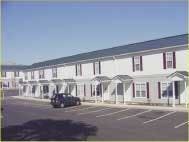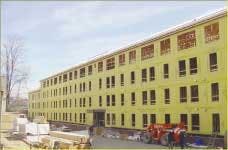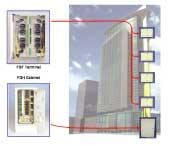Bringing fiber to the multi-dwelling unit
A hot new broadband amenity is starting to turn heads.
Welcome to this article, ladies and gentlemen. We’re going to start you off with a short pop quiz today to get things rolling. (And you thought you were going to just sit there and browse leisurely through this article without fully engaging your mind? Ha!) Seriously now, this can be quite simple, and possibly even enjoyable for you scholastic types.
Question 1 of today’s quiz: Take a look at the two apartment listings below and choose the best option.
A) 2 bedrooms, 1.5 baths, 950 square feet with hardwood floors, granite countertops, washer/dryer, balcony, vaulted ceilings, and covered parking. $1,200 per month. Broadband availability: cable modem at 5 Mbits/sec asymmetric data, 1 phone line, digital cable package with 10 channels in HDTV format. $140 per month.
B) 2 bedrooms, 1.5 baths, 950 square feet with hardwood floors, granite countertops, washer/dryer, balcony, vaulted ceilings, and covered parking. $1,200 per month. Broadband availability: Optical-fiber connection at 100 Mbits/sec symmetric data, 4 phone lines, user-defined television programming with 100 channels in HDTV format. $120 per month.
Time’s up. Lock in your final answer now.
For those of you who chose “A,” calmly put down this magazine, locate the nearest phone, and contact the author of this article immediately.
For the rest of you who chose “B,” congratulations. Continue reading at your leisure, and I can promise that you will encounter no additional surprises within this article. I think.
Are the premium broadband amenities listed with Apartment B, at a monthly rate that is cheaper than most standard, widely available packages today? The answer, perhaps surprisingly, is yes. When comparing the options of different housing amenities and features, the latest in broadband connectivity stands out, as in the example above.
Let’s take a closer look at countertops, as a comparative example. Intuitively, most of us would recognize and appreciate the fine quality, look, and feel of granite countertops compared to more basic, laminate countertops. And because of granite’s desirability, few of us would question paying considerably more for such an amenity.
Broadband services, on the other hand, have started to follow a different stream of logic than other household amenities, which actually benefits the customer. As broadband connectivity continues to evolve, service providers are now more focused on enriching the user experience rather than blanketing a service area with bandwidth-limited, predetermined offerings.
The enabling technology that is enriching this broadband experience is fiber-to-the-premises (FTTP) and fiber-to-the-multi-dwelling-unit (FTTM), which places a standard singlemode optical fiber right up to a residential unit or home, instead of the traditional copper drop.
The primary, life-enriching benefit is a single network connection with vastly increased bandwidth capability that serves as the gateway for all residential services, including voice, data, and video. What’s more, these premium broadband amenities can be had for a lower monthly rate than legacy offerings, which is a feature few of us would pass up.
FTTM at 30,000 feet
When taking a closer look at the various fiber-network architectures and approaches to deployment with respect to multi-dwelling units (MDUs), it is worthwhile to review the general FTTP architecture that is representative of numerous deployments today. In the context of this article, MDUs are defined as structures housing two or more residential units, such as apartment buildings or high-rise residential buildings.
Typically, an optical line terminal (OLT) placed within the wire center, or central office, serves as the launch point for an FTTP network. The transmission proceeds downstream via feeder cables to fiber distribution hub (FDH) cabinets, where optical splitting occurs for a passive optical network (PON). From the optical splitter output, the signal carries on to the subscriber premises via distribution cables, fiber service terminals, and drop cables. At the subscriber premises, the drop cable connects to an optical network terminal (ONT), at which point the optical signal is converted to an electrical signal for delivery of services to such devices as televisions, computers, and phones. MDUs represent just one of the possible premises extensions of an FTTP network.
Planning for fiber deployments to MDUs requires that you consider several key parameters that will influence the direction taken for a given project implementation. These parameters will be covered in more detail, but it is important to understand that each possible combination of these factors governs the deployment methodology as well as the product set used to optimize the network servicing the building.
Greenfield vs. overbuild scenarios
Perhaps the most significant parameter that will influence deployment strategy is whether the MDU building already exists, or if it will be greenfield (new construction). Greenfield buildings vastly simplify FTTM network deployment, as access to cable pathways and relative flexibility in conduit placement exists from the start of the project.
The same cannot be said for MDU network overbuild situations, in which installers are likely to encounter significant hurdles with respect to aesthetic cable placement. Consequently, expensive “cover-up” hardware, such as channeled crown molding and baseboard covers, may be required to hide and protect optical cables in these situations. From both material and labor standpoints, these items can significantly increase the overall deployment cost.
The key to streamlining and FTTM deployment in either a greenfield or overbuild scenario is certainly easier stated than done; however, through maintaining close coordination among the various contractors involved, and timing placement of the optical network components to minimize impact to the overall project, the evolution can be completed smoothly. In any case, try to arrive on the scene before anxious contractors hang drywall, turning your greenfield into an overbuild situation.
Sizing up MDU buildings
Another parameter governing the deployment is the size of the structure itself. In general, it is convenient to apply a simple size scale to label the different categories of MDU buildings. The size of an MDU structure has a profound effect on the deployment approach taken and, consequently, the product set employed. Similar to the wide array of sizes and shapes of single-family homes available today, MDUs can be found in at least as many configurations.
To simplify the FTTM deployment methodology, the size of an MDU can be binned into one of three categories: small, medium, or large.
At the bottom of the scale lie the small MDUs. This league of buildings typically includes apartments, townhouses, or condominiums with a maximum of 12 residential units per building (see photo, previous page). With a low number of residences, small MDUs rarely exceed three floor levels in height. Additionally, the entryways to residential units in buildings of this size are usually located external to the structure, eliminating the need for environmentally controlled hallways and stairways. The very nature of small MDUs will oftentimes afford you the opportunity to deploy fiber to these structures in much the same way that you would construct a network to serve single-family homes.
Moving up the chart, to medium MDUs, the network topology picture changes significantly. Medium-size MDUs are typically multi-level structures featuring internal residential entry (see photo, top of page 20). This size typically spans buildings that accommodate from 12 to 128 residential units.
Rounding out the list is the large MDU building class. This size of structures covers buildings having greater than 128 residential units. These buildings are represented by high-rise or ultra high-rise residential structures, and are typically greater than 10 stories in height (see photo, below). Large MDUs rarely feature external residential entryways, so in most cases, network deployments to and within the buildings can be treated in much the same manner as deployments to medium-size MDUs.
To share, or not?
Looking more closely at the network-edge gear to be deployed, another important variable with FTTM installation is the type of ONT to select for a particular application.
Residential ONTs can be boiled down to one of two main categories: single-family unit (SFU) and multi-dwelling unit. SFU devices normally are designed to serve a single residential unit, with the number of network delivery ports scaled accordingly off of the circuit board. An MDU ONT, on the other hand, features sufficient network connections to deliver service to several residential units.
To select the proper ONT for tyour FTTM application, you’ll need to take several factors into account. First, while it would seem intuitive to deploy a single electronic device versus 4 to 8 individual electronic devices to deliver broadband services within a building, those extra network connections don’t come for free. So, the cost of drop cable must also be considered in your equation.
An MDU ONT can be fed with a single fiber drop, but the final link to the residential unit requires a combination of coaxial and twisted-pair cables. This approach can become costly depending on the number of units served and also the length of copper cabling required in the horizontal to each unit. Alternatively, each SFU ONT requires a single-fiber drop; however, the copper cabling in this scenario is limited to shorter-length, in-home wiring, the cost of which is typically covered by the building owner.
The last consideration is that of bandwidth scaling and security. An SFU ONT can be capable of providing the highest dedicated bandwidth, while an MDU ONT must share bandwidth among the multiple subscribers that it serves.
Putting it all together
Now that we have discussed some of the driving factors and design considerations that influence the direction of FTTM deployments, let’s look at an example of the network components that make up the optical link to these buildings. In this case, we’ll trace the network elements for an FTTM system serving either a medium or large MDU building.
In residential buildings of this size, which commonly feature a basement or utilities space, the physical location of the FDH can actually be transitioned inside of the structure. Therefore, a feeder cable from the central office or headend directly services this point in the network. For a PON, the FDH would hold passive optical splitters to serve the residential units within the MDU. The FDH for an MDU application differs from an outside-plant FDH in that it does not require the same level of environmental protection, and it can also be wall-mounted to save space.
At the output of the FDH, riser-rated optical cables serving one or more floors are distributed in a star topology, and are analogous to the OSP distribution cable link in an FTTH network. These riser cables connect the output ports of the splitter for a PON, or the feeder patch for a point-to-point network, to the fiber distribution terminal (FDT).
The FDT is a thin-profile, wall-mountable device that allows for connecting drop cables to the distribution fibers. From the FDT point, individual drop cables are connected and run to residential units, where the ONT resides just inside of the living space (see photo, above).
Your competitive edge
As the competitive battle for winning over residential subscribers will only continue to escalate in the years to come, there are now technology options available that let you cost-effectively place the advantage in your own hands. FTTH, and now FTTM, are the differentiating network technologies that ensure this advantage not only today, but also well into the future.
And remember, when given the choice, go with Apartment B.
DAVID MEIS is manager of FTTX technology with Corning Cable Systems (www.corningcablesystems.com).




